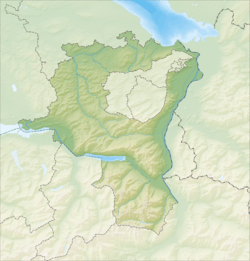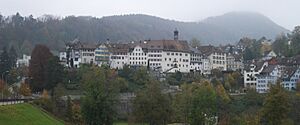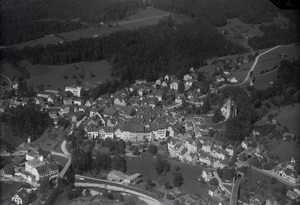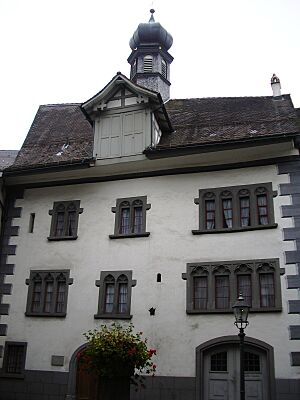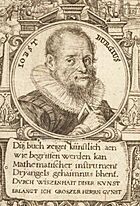Lichtensteig facts for kids
Quick facts for kids
Lichtensteig
|
||
|---|---|---|
 |
||
|
||
| Country | Switzerland | |
| Canton | St. Gallen | |
| District | Toggenburg | |
| Area | ||
| • Total | 2.82 km2 (1.09 sq mi) | |
| Elevation | 625 m (2,051 ft) | |
| Population
(Dec 2020 )
|
||
| • Total | 1,879 | |
| • Density | 666.3/km2 (1,726/sq mi) | |
| Postal code |
9620
|
|
| Surrounded by | Bütschwil, Oberhelfenschwil, Wattwil | |
| Twin towns | Adelberg (Germany) | |
Lichtensteig is a small town, also called a municipality, located in the Toggenburg area of the St. Gallen region in Switzerland. It's a charming place with a rich history and beautiful natural surroundings.
Contents
History of Lichtensteig
Lichtensteig was first established by the counts of Toggenburg in the early 1200s. It was officially mentioned in records in 1228.
Early Town Life
By 1374, Lichtensteig was known as a market town, a place where people could buy and sell goods. Its right to hold markets was confirmed in 1400. In 1439, a special document from the lords of Raron confirmed that the town had a council of twelve citizens. These citizens helped choose judges along with the local lords. The town's leader, called a Schultheiss (like a mayor), was chosen by the local lord from a list of candidates the citizens put forward.
Changes Over Time
In 1468, the Toggenburg region became part of the Abbey of St. Gallen, a powerful monastery. Lichtensteig then became the home of the abbot's reeve, who was like a local governor. In 1469, Abbot Ulrich Rösch confirmed all the special rights Lichtensteig already had.
Religious Changes
In 1528, during the Reformation, the town council decided to support the new Protestant faith. For a long time, the same church building in Lichtensteig was used by both Protestants and Catholics. Schools, however, were kept separate for each religion until 1868. A new church was built in 1868, still shared by both groups. But later, in 1967 and 1970, two separate churches were built.
Growth and Development
Lichtensteig became even more important as a market town in the 1800s. This was because of the growing textile industry in the Toggenburg region, where people made fabrics at home. In the early 1900s, the town held six markets every year, plus a weekly market for livestock. The town got its railway connection in 1870. A few years later, in 1874, the nearby areas of Blatten, Hof, and Loretto joined Lichtensteig.
Town Symbols
Lichtensteig adopted its first official coat of arms in the 1500s. It was later changed to red and black. In the 1600s and 1700s, the town used a seal with the letter "L" and a decorative branch. A flag from 1767 showed the letter "L" on a red background. These symbols were combined in 1946 to create the modern coat of arms. It shows a golden letter "L" on a shield that is half red and half black.
Geography of Lichtensteig
Lichtensteig is located in the beautiful Toggenburg valley, which is the upper part of the Thur River basin. The town sits on the right side of the Thur River. It is downstream from Wattwil and upstream from Dietfurt (which is part of Bütschwil municipality). It's also on the western side of the Wasserfluh Pass.
Natural Features
Above the village, you can find the ruins of Neu-Toggenburg castle on a rocky hill. Lichtensteig is the smallest town in Toggenburg by area, covering only about 2.8 square kilometers (1.1 square miles). About 35.7% of the land is used for farming, 44.6% is covered by forests, and 18.2% has buildings. The rest (1.4%) is made up of water bodies like rivers. The highest point in Lichtensteig is Köbelisberg, at 1,146 meters (3,760 feet) above sea level. The lowest point is untere Platten, at 591 meters (1,939 feet).
People of Lichtensteig (Demographics)
Lichtensteig has a population of 1,879 people (as of 31 December 2020). About 19.1% of the people living here are from other countries. Most people in Lichtensteig (about 89.6%) speak German. Italian is the second most common language (2.7%), followed by Serbo-Croatian (2.0%).
Age Groups
In 2000, about 9.9% of the population were children aged 0-9, and 13.0% were teenagers aged 10-19. About 14.2% were young adults aged 20-29. The largest group, 17.3%, were between 30 and 39 years old. Older adults, aged 60 and above, made up about 20.5% of the population.
Education and Work
Most people in Lichtensteig (about 69.2% of those aged 25-64) have completed either high school or gone on to higher education like university. In 2000, 350 residents worked in Lichtensteig itself, while 704 residents traveled to other places for work. Also, 521 people came into Lichtensteig for their jobs.
Historical Population
Here's how the population of Lichtensteig has changed over time:
| year | population |
|---|---|
| 1560 | c. 400 |
| 1850 | 875 |
| 1900 | 1,387 |
| 1950 | 1,798 |
| 2000 | 1,893 |
Important Buildings and Sites
The Old Town Council building at Hintergasse 22 is a very important building in Switzerland. It's listed as a heritage site of national significance. The entire village of Lichtensteig is also recognized as an important part of Swiss heritage.
Economy of Lichtensteig
Lichtensteig has a mix of different types of jobs. In 2005, a small number of people (17) worked in the primary economic sector, which includes things like farming. More people (340) worked in the secondary sector, which involves making things, like in factories. The largest number of people (309) worked in the tertiary sector, which includes services like shops, offices, and healthcare.
Religion in Lichtensteig
Based on the 2000 census, about 52.0% of the people in Lichtensteig are Roman Catholic. About 29.3% belong to the Swiss Reformed Church (Protestant). There are also smaller numbers of people who are Orthodox Christian, other Christian faiths, or Islamic. About 5.76% of the population said they didn't belong to any church or were agnostic or atheist.
Notable People from Lichtensteig
- Jost Bürgi (1552–1632): He was a famous Swiss clockmaker, who also made tools for studying the stars and was a mathematician.
- Augustine Reding (1625–1692): A Swiss Benedictine monk who became the Prince-Abbot of Einsiedeln and wrote many theological books.
- Max Rychner (1897–1965): A Swiss writer, journalist, translator, and literary critic.
- Paula Rueß (1902–1980): A German political activist who had to leave her home because of the Nazis. In the 1940s, she worked with the French Resistance, a group that fought against the occupation.
See also
 In Spanish: Lichtensteig para niños
In Spanish: Lichtensteig para niños




